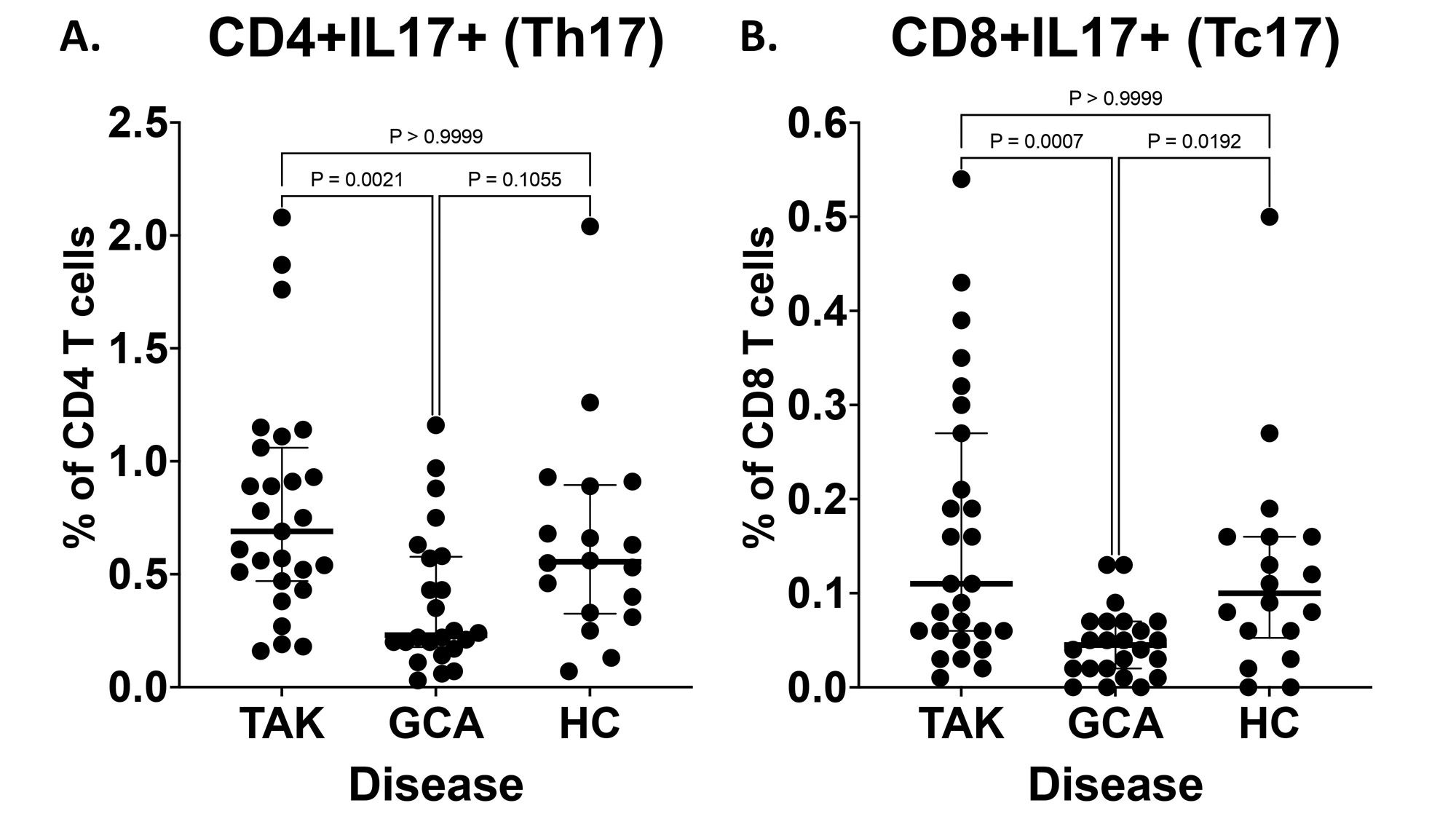Session Information
Date: Sunday, November 12, 2023
Title: (0691–0721) Vasculitis – Non-ANCA-Associated & Related Disorders Poster I
Session Type: Poster Session A
Session Time: 9:00AM-11:00AM
Background/Purpose: Large-vessel vasculitis (LVV) is characterized by granulomatous inflammation of the aorta and its major branches. The two major forms are giant cell arteritis (GCA) and Takayasu’s arteritis (TAK). Clinical manifestations and angiographic patterns of diseases can be similar between these diseases; however, GCA exclusively affects older people while TAK is frequently a disease of the young. Few studies directly compare circulating immune cell subsets between TAK and GCA. Some studies have independently shown involvement of Treg, Th1, and Th17 subsets in GCA and TAK. The study objectives were to profile human peripheral blood mononuclear cells (PBMCs) using spectral flow cytometry and directly compare CD4+ T helper (Th) and CD8+ cytotoxic T cell (Tc) subsets between patients with GCA and TAK.
Methods: Cryopreserved PBMCs, collected during active disease from patients with LVV enrolled in an observational cohort study and from healthy controls (HC), were profiled. A 30-color panel for spectral flow cytometry was designed. Each antibody was titrated to determine its optimal volume and then adjusted until the staining pattern was comparable between multicolor and single-color staining. The two conditions tested involved 4-6 h PBMC incubation with PMA, ionomycin, and Brefeldin A (stimulated) and in media alone (unstimulated). Treg, Th1, Th2, Th9, Th17, Tc1, Tc2, Tc9, and Tc17 subsets were defined as the proportion of CD4 or CD8 T cells expressing a key transcription factor or cytokine. Kruskal-Wallis tests were conducted to compare between groups. Spearman correlation was reported for comparisons of subset abundance and age within HC.
Results: Patients with active GCA (N=24, ages 54-88), patients with active TAK (N=27, ages 15-54), and HC (N=18, ages 14-74) were included. Statistically significant differences between TAK and GCA were only observed in Th17 and Tc17 subsets. TAK patients (median 0.69%) showed significantly higher Th17 (CD4+IL17+) compared to GCA patients (0.23%, p=0.002) but not HC (0.56%, p >0.999) (Figure 1). GCA patients (0.05%) had significantly lower Tc17 (CD8+IL17+) levels than TAK (0.11%, p=0.001) and HC (0.10%, p=0.033) (Figure 1). Neither of Th17 nor Tc17 correlated with age within the HC group (r=-0.194 and r=-0.1741 respectively). There were no significant differences between TAK and GCA for Th1 and Tc1 populations. TAK patients (31.7%) did have lower Tc1 (CD8+IFNg+) than HC (56.1%, p=0.028). The only significantly difference observed in Tregs (CD4+FOXP3+) was lower expression in GCA patients (4.99%) than HC (7.06%, p=0.004).
Conclusion: Abundance of Th17 and Tc17 subsets were greater in TAK compared to GCA with no differences in Treg, Th1, or Tc1 subsets. Differences in IL17-producing T lymphocytes may be a fundamental immunologic difference between GCA and TAK and may inform novel therapeutic strategies in these conditions. A lack of strong differences in circulating immune cell populations between TAK, GCA, and HC suggests that profiling peripheral blood may not be as informative as direct study of affected arterial tissue in these conditions.
To cite this abstract in AMA style:
Kuan R, Redmond C, Sylvester M, Maclean M, Meylan F, Ferrada M, Quinn K, Grayson P. T Cell Subset Analysis in Patients with Large-Vessel Vasculitis [abstract]. Arthritis Rheumatol. 2023; 75 (suppl 9). https://acrabstracts.org/abstract/t-cell-subset-analysis-in-patients-with-large-vessel-vasculitis/. Accessed .« Back to ACR Convergence 2023
ACR Meeting Abstracts - https://acrabstracts.org/abstract/t-cell-subset-analysis-in-patients-with-large-vessel-vasculitis/

